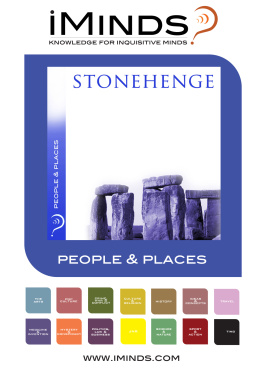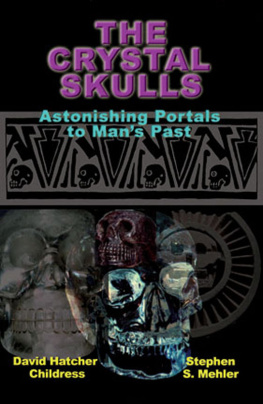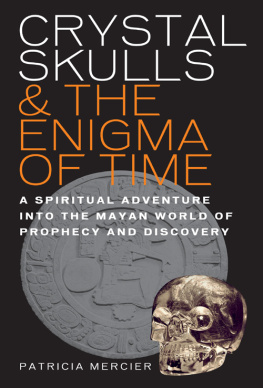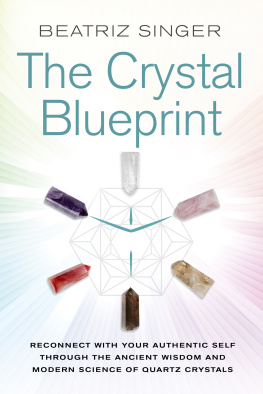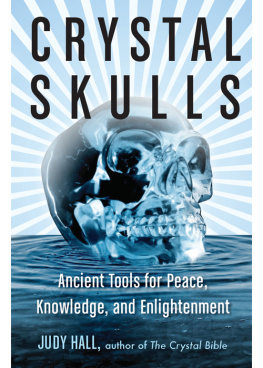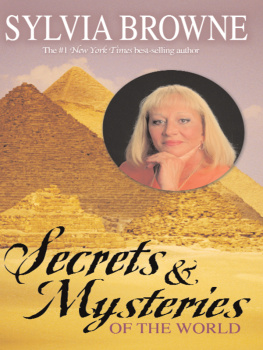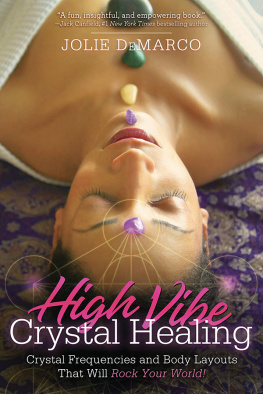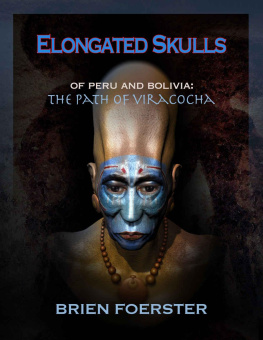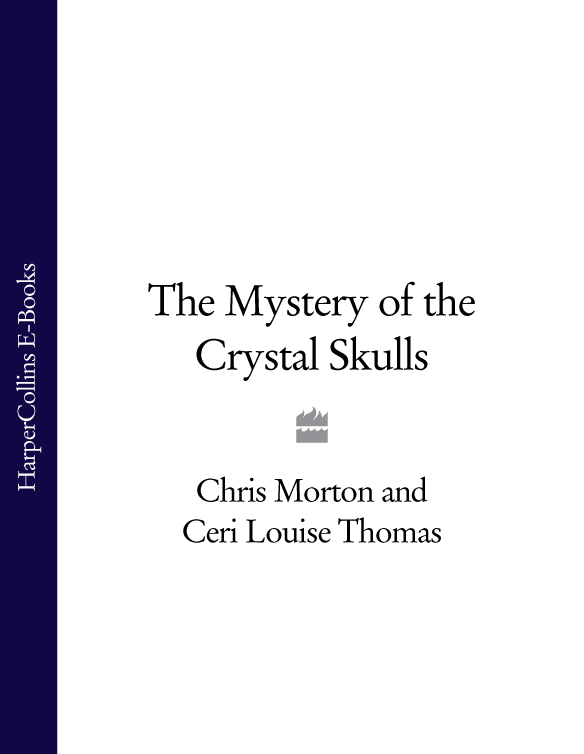THE MYSTERY OF
THE CRYSTAL SKULLS
As profound as the pyramids of Egypt,
the Holy Grail or Stonehenge
CHRI SMORTON AND CERI LOUISE THOMAS
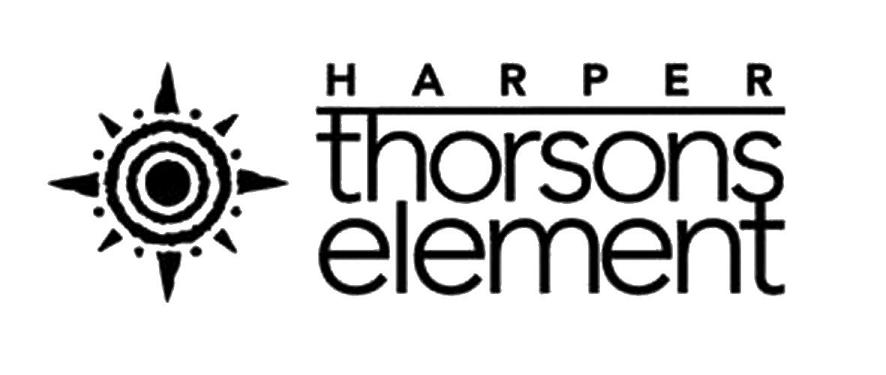
CONTENTS
TO THE EARTH, AND ALL HER CHILDREN
There are more things in Heaven and Earth, Horatio,
Than are dreamt of in our philosophy.
William Shakespeare, Hamlet

Figure 1: Map of Mesoamerica (ancient central america)

It was just before dawn and we were deep in the jungle, trekking through the dense undergrowth to get to the ruins of the once great Mayan city buried somewhere deep within. In the darkness of the rainforest your mind starts to play tricks on you. You start to see and hear all manner of strange things creatures, spirits, shadows of the unknown. It was then we heard the terrifying roar of a jaguar. In one split second that sound, cutting through the background of jungle noises, and all too close at hand, shattered our illusions of self-confidence, suddenly reminding us of our own delicate mortality. We stopped, for an instant frozen with fear, before turning in our tracks and stumbling off, as fast as we could, into the vast darkness of the unknown.
We were in one of the most beautiful places in the world, Central America, on the holiday of a lifetime, visiting the ancient Mayan ruins of Tikal in Guatemala. We were trying to reach the crumbling temples, palaces and pyramids before dawn. There we would wait for the sun to rise slowly from the surrounding greenery to cast whispers of yellow-golden light over the crumbling remains of this once great civilization, as if bringing it back to life. The jungle canopy is over 200 ft (60 m) high and yet the crumbling pyramids, some still covered in creepers and vines, reach right up through it to the heavens above. From atop one of these great mountains of human endeavour, whichever way you turn, the rainforest stretches as far as the eye can see. It could be a blanket of clouds or a vast ocean below, a beautiful ocean of green, where bright-coloured macaw and toucans sweep across golden pyramids that rise like rocks from the shore.
It was in this forgotten city that we saw our first skull, that symbol of death which normally strikes fear into the heart of modern man. It was a stone skull, carved into the side of one of the pyramids. To us this was a monstrous image. But our guide, Carlos, explained that to the ancients who had carved it, the skull had quite a different meaning. The Mayans and other ancient tribes of Central America had a different understanding of death from our own. To them death was not a full stop. It was not something to be afraid of, but rather something to look forward to, a great opportunity to pass into another dimension, a chance to join with the world of the spirits and the ancestors. To these ancient people death was part of the balance of nature, part of giving back to Mother Earth the life she had given. The skull, it seemed, was symbolic of this view. And then Carlos told us the legend of the crystal skulls
According to an old Native American legend, there are 13 ancient crystal skulls, the size of human skulls, with movable jaws, that are said to speak or sing. These skulls are said to contain important information about the origins, purpose and destiny of mankind and answers to some of the greatest mysteries of life and the universe. It is said that this information is not only important to the future of this planet, but vital to the very survival of the human race. According to these ancient teachings, one day all of the crystal skulls will be rediscovered and brought together for their collective wisdom to be made available, but the human race must first be sufficiently evolved, both morally and spiritually, so as not to abuse this great knowledge.
This legend, said Carlos, had been handed down by generations of Native Americans over thousands of years. Indeed, as we were to discover, variations on this legend are found amongst several Native American tribes, from the Mayan and Aztec descendants of Central America to the Pueblo and Navajo Indians of what is now the south-western United States, right up even to the Cherokee and Seneca Indians in the north-eastern USA. The Cherokee version of the legend, for example, says that there are 12 planets in the cosmos inhabited by human beings and that there is one skull for each of these planets, plus a thirteenth skull vital to each of these worlds.
Of course, when we first heard Carlos brief words, standing on the steps of one of the pyramids of Tikal, we thought the legend was a fascinating story a snippet of ancient mythology, a wonderful, colourful tale, but a story, just a story, nothing more than that. It was an interesting curiosity that we might just recount to friends when we got back home.
What we didnt know then was that we were about to discover something that would change our view of the legend quite dramatically, something that would lead us on an adventure, on a journey of mystery, intrigue and wonder. It was to be a quest that would take us right across two continents, from the jungles and ancient ruins of Central America to the remote palm-fringed islands of Belize, and from the cold snows of Canada to the deserts of the United States. It would be a journey that would take us from the corridors of the British Museum in London and the laboratories of one of the worlds leading computer companies in California to a sacred gathering in a secret location deep in the mountains of Guatemala. Along the way we would meet some of the worlds leading scientists and archaeologists, encounter UFO investigators, psychics and mystics, and hear words of great wisdom from native elders, shamans and medicine men. We would uncover strange facts, hear ground-breaking new scientific theories and learn of ancient teachings kept secret for thousands of years. It was to be a journey where we would learn that things are not always as they seem and that truth can be stranger than fiction. It was also a personal voyage of discovery where we would explore our own attitudes to life and death and our place in the universe, an inner journey that would take us into the darkest reaches of the human soul.
In the meantime, before leaving the ruins of Tikal, Carlos told us a little more about the ancient Mayan civilization that had built the great city that now lay in ruins before us. It was a civilization which stretched across a vast area of Central America, from what is now southern Mexico in the north to Honduras in the south, and from the Pacific coast of Guatemala in the west to the Atlantic and Caribbean coast of Belize in the east. This area spanned the tropical forests of Chiapas, the highlands and steaming lowlands of Guatemala, and the huge expanse of low-lying savanna stretching out into the Atlantic Ocean known as the Yucatn Peninsula.
As Carlos explained, the ancient Maya built one of the most advanced and sophisticated civilizations the world has ever known. The cities that remain include the large, bold and militaristic Chichen Itz; Uxmal, with its monumental architecture, carved snakes and weird chac-mool figurines; the deeply aesthetic and beautifully proportioned Palenque; Tulum, set against the white sandy beaches and azure waters of the Caribbean Sea; and the once thriving metropolis of Tikal, which now stood crumbling before us, but which had once housed over 50,000 inhabitants.


